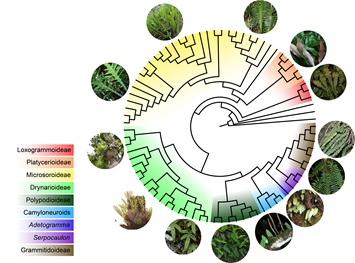The polygrammoids (Polypodiaceae) are the most species-rich and diversified epiphytic fern lineages, consisting of ca. 1600 species, with two distribution centers in tropical Asia and tropical America.
Despite the progress achieved in the systematics of Polypodiaceae, uncertainty remains especially in backbone relationships among closely related clades and the phylogenetic placement of recalcitrant species or clades.
The poor resolution of the phylogeny of Polypodiaceae is likely a consequence of the paucity of genetic information from only a few genetic markers, which is largely due to the recent rapid diversification and evolutionary heterogeneity found in this group of ferns.
The research group led by Prof. ZHANG Xian-Chun, from the Institute of Botany, Chinese Academy of Sciences (IBCAS), with the help from international counterparts, investigated the deep phylogenetic relationships within Polypodiaceae based on plastome data of 78 species, which represents all the major polygrammoid clades.
Using simulated data matrices, researchers detected that the potential phylogenetic artefact, such as long-branch attraction and insufficient taxonomic sampling, may have a confounding impact on the incongruence of phylogenetic inferences.
They achieved a better resolution of the backbone phylogeny of Polypodiaceae, and provided a robust framework, including nine clades potentially representing nine subfamilies: Loxogrammoideae, Platycerioideae, Microsoroideae, Crypsinoideae, Grammitidoideae, Polypodioideae, Campyloneuroideae, Adetogrammoideae, and Serpocauloideae, which may stand for future phylogenetic implications on the subfamilial taxonomy of this family.
The delimitation of the nine clades was also supported by the morphological evidence, such as the scale features of rhizomes, leaf division patterns, venation patterns, paraphysis features, soral features and spore morphologies.
“This study not only demonstrates the advantage of plastome data for resolving the phylogeny of recalcitrant lineages, but also sheds new light on integrative explorations understanding the evolutionary history of large fern groups in the genomic era.” Said Prof. ZHANG Xian-Chun, the correspondence author.
This study was published online in the journal Cladistics. It was supported by grants from the National Science Foundation of China.

Phylogenetic framework of Polypodiaceae (By IBCAS)
Article link:https://doi.org/10.1111/cla.12461
Contact:
Email: zhangxc@ibcas.ac.cn
Institute of Botany, Chinese Academy of Sciences
The polygrammoids (Polypodiaceae) are the most species-rich and diversified epiphytic fern lineages, consisting of ca. 1600 species, with two distribution centers in tropical Asia and tropical America.
Despite the progress achieved in the systematics of Polypodiaceae, uncertainty remains especially in backbone relationships among closely related clades and the phylogenetic placement of recalcitrant species or clades.
The poor resolution of the phylogeny of Polypodiaceae is likely a consequence of the paucity of genetic information from only a few genetic markers, which is largely due to the recent rapid diversification and evolutionary heterogeneity found in this group of ferns.
The research group led by Prof. ZHANG Xian-Chun, from the Institute of Botany, Chinese Academy of Sciences (IBCAS), with the help from international counterparts, investigated the deep phylogenetic relationships within Polypodiaceae based on plastome data of 78 species, which represents all the major polygrammoid clades.
Using simulated data matrices, researchers detected that the potential phylogenetic artefact, such as long-branch attraction and insufficient taxonomic sampling, may have a confounding impact on the incongruence of phylogenetic inferences.
They achieved a better resolution of the backbone phylogeny of Polypodiaceae, and provided a robust framework, including nine clades potentially representing nine subfamilies: Loxogrammoideae, Platycerioideae, Microsoroideae, Crypsinoideae, Grammitidoideae, Polypodioideae, Campyloneuroideae, Adetogrammoideae, and Serpocauloideae, which may stand for future phylogenetic implications on the subfamilial taxonomy of this family.
The delimitation of the nine clades was also supported by the morphological evidence, such as the scale features of rhizomes, leaf division patterns, venation patterns, paraphysis features, soral features and spore morphologies.
“This study not only demonstrates the advantage of plastome data for resolving the phylogeny of recalcitrant lineages, but also sheds new light on integrative explorations understanding the evolutionary history of large fern groups in the genomic era.” Said Prof. ZHANG Xian-Chun, the correspondence author.
This study was published online in the journal Cladistics. It was supported by grants from the National Science Foundation of China.

Phylogenetic framework of Polypodiaceae (By IBCAS)
Article link:https://doi.org/10.1111/cla.12461
Contact:
Email: zhangxc@ibcas.ac.cn
Institute of Botany, Chinese Academy of Sciences
